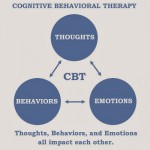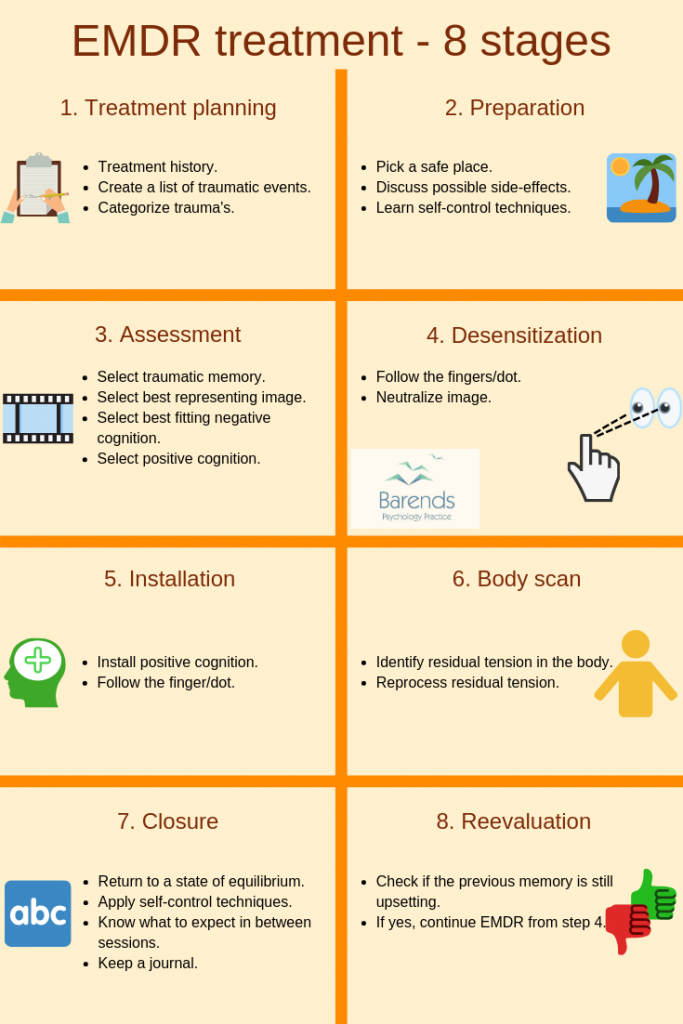PTSD treatment
Post-traumatic stress disorder (PTSD) treatment can help you to regain control over your life. Psychotherapy is the treatment of choice, sometimes accompanied by medication. PTSD treatment can reduce or completely take away PTSD (symptoms). It usually only takes a few sessions to treat PTSD, especially when EMDR therapy is applied.
PTSD treatment can take (a lot) longer when someone experienced multiple or prolonged and repetitive traumatic events. Other factors also affect treatment duration, such as: the severity of the PTSD, presence of other mental disorders, and (re)processing of the traumatic events.
Medication is recommended when someone is severely traumatized and dissociates during psychotherapy. Dissociation is when someone detaches from the immediate surroundings. It is possible for someone with PTSD to dissociate in such a way that the therapist or other people are unable to ‘reach’ them. Dissociation is a way to protect oneself from emotional and physical pain.
At Barends Psychology Practice, we offer online Eye Movement Desenzitisation and Reprocessing (EMDR) and exposure therapy to treat PTSD, because both are very effective and cost-effective for the client [1]. Here is an overview of the different PTSD treatment types and their effectiveness.
At Barends Psychology Practice, we treat Post-traumatic stress disorder Online and in person. Book your first, free session now. Contact us. (Depending on your health insurance, treatment may be reimbursed).
Jump-to:
Eye movement desensitization and reprocessing (EMDR)
According to Francine Shapiro, EMDR, a distressing or traumatic event may overwhelm normal cognitive and neurological coping mechanisms. This can result in an inadequate way of storing and processing the memory and associated stimuli of that distressing or traumatic event into an isolated network. The goal of this PTSD treatment is to process these distressing memories, reducing their lingering effects and developing adequate coping mechanisms. Effectiveness of EMDR: EMDR is as effective as Cognitive Behavioural Therapy (CBT) treatment [1],[2],[3] but usually requires less sessions.
Another advantage of EMDR: if a traumatic experience is too difficult to share due to feelings of shame, disgust or humiliation, the patient can choose not to tell the therapist about the details. Even when the therapist is not aware of the details of the traumatic experience, EMDR treatment is very effective.
How does EMDR treatment work?
EMDR treatment consists of 8 stages and all are equally important when it comes to PTSD treatment. Although originally developed for face-to-face session, EMDR treatment can also be done online (but only under supervision of an EMDR therapist).
We’ve added a traumatic events form for you to fill out before your first EMDR session. If you have any question, don’t hesitate to contact us.
We’ll discuss each stage briefly:
Stage 1 – Treatment planning
EMDR treatment is most successful when the most representative image is selected for a traumatic event. In case of multiple traumatic events, it is important to start with the traumatic event that is the most upsetting one, the earliest one or most significant one in order for PTSD treatment to be as successful as possible. That is why the therapist needs a list with traumatic events and a treatment history of the client. Please note that the client can always decide not to share details about the traumatic event with the therapist. In that case it is important to give the event a name and the selected image as well. The therapist may ask you a few questions related to the image, such as: ‘Do you see yourself in the image?’, which should be safe to answer.
Stage 2 – Preparation
Stage 3 – Assessment
The assessment stage is very important as it focuses on selecting the most representative image of a traumatic event. Selecting the wrong image could results in a less effective or even not effective EMDR session. Sometimes there are multiple images during one traumatic event. These need to be rated and together with the therapist the client decided with which image they’ll start the desensitization proces. The therapist will determine the negative cognition and the positive cognition. This should not take longer than a minute.
The selected images are rated on a Subjective Units of Disturbance scale and ranges from 0 to 10 (0 being neutral; 10 being as disturbing/upsetting as possible).
Stage 4 – Desensitization
Stage 5 – Installation
The installation stage indicates that the EMDR session has almost come to and end. During this stage, the positive cognition is connected to the traumatic event. This only happens once the selected image reached a SUD of 0 or 1.
The positive cognition is rated on a 1-7 VoC-scale (Validity of Cognition) where 7 is ‘as much as possible’.
Stage 6 – Body scan
The body scan usually takes place before the Installation stage, because it signals residual tension in the body. Physical tension in the body is related to the traumatic event and is often felt while talking or thinking of the traumatic event. By focusing on these physical tensions during the desensitization process, EMDR treatment is more effective and efficient.
Stage 7 – Closure
Closure is when the therapist and client talk about the session, the client’s experiences and impression. At the same time, the therapist informs the client (again) on the possible side-effects and recommends the client to keep a diary for the coming days. In this diary the client can keep track of side-effects and new memories.
Stage 8 – Reevaluation
The next session, the therapist needs to check whether the selected image of the previous session still holds some emotional charge. If this is the case, it is important to start the desensitization process again. If this is not the case, it is safe to assume that this image is neutralized and will not bother the client again (unless the client is being retraumatized. For instance, by having another car accident after being treated for a car accident).
Cognitive Behavioural Therapy (CBT)

CBT seeks to change the way a traumatized person feels and acts by changing the patterns of thinking and behaving that are responsible for negative emotions. In therapy, upsetting and frightening thoughts are replaced by less upsetting or frightening thoughts. The goal of CBT is to understand how certain thoughts about such events can cause PTSD related-stress. Effectiveness of CBT as PTSD treatment: CBT is a safe and effective intervention for both chronic and acute PTSD. In the USA, CBT is the most often used treatment for PTSD.
(Advertisement. For more information, please scroll down.)
Exposure therapy
With exposure treatment the patient faces the frightening traumatic event several times, but now in a safe environment. Facing the traumatic event and the accompanying emotions and thoughts over and over again, reduce the power they have to cause distress. Effectiveness of exposure therapy as PTSD treatment: Exposure treatment is an effective type of treatment for both chronic and acute PTSD.
Medication

Medication is most often only prescribed in combination with therapy, because medication does not take away the flashbacks or feelings associated with the real trauma.
(Advertisement. For more information, please scroll down.)
Antidepressants – SSRIs are the most commonly used medication for PTSD and tends to decrease anxiety, depression and panic associated with PTSD, but takes 6 to 8 weeks to work. Not many people respond to the first SSRI introduced, so they need to try another SSRI and so on. On top of that SSRIs worked only better than placebo in 2 out of 4 studies. (Placebo is a fake medicine). You can read more about SSRIs in the section treating depression.
PTSD treatment – literature
[1] Rothbaum, B. O., Astin, M. C., & Marsteller, F. (2005). Prolonged exposure versus eye movement desensitization and reprocessing (EMDR) for PTSD rape victims. Journal of Traumatic Stress: Official Publication of The International Society for Traumatic Stress Studies, 18, 607-616.
[2] Lee, C., Gavriel, H., Drummond, P., Richards, J., & Greenwald, R. (2002). Treatment of PTSD: Stress inoculation training with prolonged exposure compared to EMDR. Journal of clinical psychology, 58, 1071-1089.
[3] Seidler, G. H., & Wagner, F. E. (2006). Comparing the efficacy of EMDR and trauma-focused cognitive-behavioral therapy in the treatment of PTSD: a meta-analytic study. Psychological medicine, 36, 1515-1522.


